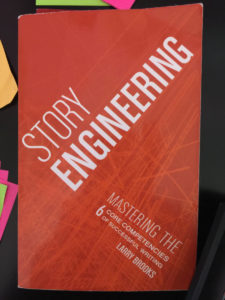Author Jerry Jenkins speaks often about the two ways most writers approach the page: with or without a plan. Those without a plan are called “pantsers”—as in, they fly by the seat of their pants. Or, as Stephen King has said, “Try to put interesting characters in difficult situations and write to find out what happens.” Those with a plan are known as “planners” or “outliners”—they work out the details of their story before they start telling it.
No matter how you approach storytelling, certain criteria must be met. A specific set of elements feeds a good story. Not one can be ignored. That’s true whether you seek a traditional publisher or you’re self-published. If you don’t develop each element well, you’ll lose readers.
Larry Brooks covers them in his book, Story Engineering: Mastering the Six Core Competencies of Successful Writing. So what are they?
- Concept: the idea or seed that develops into a story platform. It’s most powerful when expressed as a “what if” question.
- Character: no protagonist, no story. We don’t need to like the main character, but we do need to cheer for him.
- Theme: what your story says about real life.
- Structure: you can’t cobble this together based on whatever you think is right. Expectations and standards apply, and you need to heed them.
- Scene Execution: a story is a succession of connected scenes. Again, principles and guidelines apply.
- Writing Voice: how you deliver your story. A minimalist approach is best—one that’s clever and eloquent.
These terms can be casually tossed about in the literary world. Podcasts, webinars, and conferences might cover them in a cursory way. Few offer writers in-depth instruction so they come away with a firm understanding of each element and how to master all six. This is important for writers of all levels.
How do the six competencies work together to form a well-crafted story? Brooks does an excellent job of answering that.
The Importance of the First Four
He calls the first four competencies “elemental,” and the last two “execution-driven.” A story idea is rooted in one of the first four—usually in concept, character, or theme. It doesn’t matter which competency you develop first. To have a well-rounded, sellable story, the first four must be fully refined and commingled.
Nailing down a story idea is just the first step. Yet many writers plunge into writing as soon as they have an idea. For example, if your idea arises from a character, and you focus solely on that, your story will get stuck somewhere—unless you also develop concept, theme, and structure.
Brooks says sound story planning means spending significant time working out the first four competencies and creating a linear structure before you begin writing. If you do this, once you dive into your first draft, it’ll be “as much an exercise in structural execution as it is a search for character and theme.”
Story Ideas: Rooted in Mystery and Hard Work
Dreams, thoughts, long-held notions—story ideas can be rooted in any of these. “I like to say that we are gifted with that first initial seed of a story, and from a place we don’t completely control or understand,” Brooks says.
An idea will always come from only one of the first four competencies. Once you determine which of the four elements gave rise to your idea, the second element can follow fast.
For instance, your idea for a novel about the British monarchy evolves into a concept: What if the modern monarchy is uprooted and dissolved from within? On the heels of your concept comes your character, a modern-day knight who touts a better way for the U.K.
After this one-two inspirational punch, much hard work awaits. You must refine your first two elements, and develop the other two. “They must be conjured, contoured, and fitted together into a seamless whole. We get to play God with our story from that point forward. And therein lies the hard work of storytelling. Because, if you’re playing God, you need to get it right,” Brooks says.
What to Develop—Not How to Do It
The Six Core Competencies model focuses on what you need to know and implement, not on how you do it. Whether you’re an outliner or you take an unrehearsed approach to writing, if you apply the model, your first draft will be far cleaner than it would be without the model.
The artistic process is up to you. There’s joy and discovery in that process, something many writers relish. No matter how we approach it, we all find ourselves at the same crossroads: searching for our story.
Put simply, the competencies model says this: The more we know about storytelling criteria and applying the six elements, the more effective and efficient our writing process will be. Who doesn’t want that?
Leave a Reply